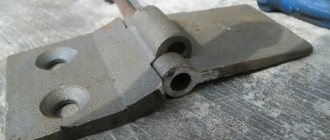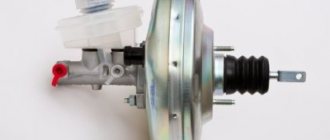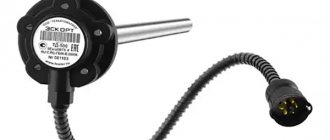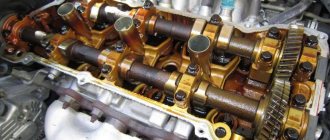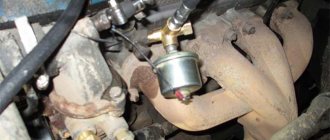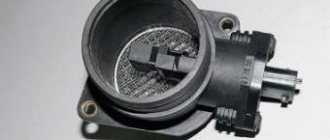06 March 2020 Lada.Online 165 600 72
Oil consumption is provided for by the engine design and cannot be equal to zero, otherwise the engine will be destroyed. At AVTOVAZ there are standards for the consumption of motor oil, and the standards are the same for all VAZ engines (starting from the VAZ 21213 engine, which is installed on the Lada 4×4, ending with modern 1.6 and 1.8 liter VAZ 21126, VAZ-21129, VAZ-21179 engines). Let's figure out how much oil a VAZ engine should consume, as well as which of the AvtoVAZ engines is the most voracious.
Why does oil consumption increase?
There are various reasons leading to excessive consumption of engine oil. To understand the reasons, you first need to determine the nature of this process, since these symptoms will make it easier and faster to identify malfunctions.
- The consumption norms were exceeded slightly, by about 15-20%.
- Heavy burning - oil consumption approaches 1 liter on short runs.
- A certain amount disappears over a short period of time (the level decreases constantly by the same value).
- The amount of oil decreases “in spurts”, periodically giving way to periods of normal consumption.
The most common reason that an engine burns oil is overheating of the engine itself. If the overheating was insignificant and the coolant did not boil, then the engine will withstand a small amount of it without significant damage to itself. When boiling has already occurred, the driver has a direct route to a car service center.
In addition, overheating of the engine leads to damage to the valve stem seals and rings. When the caps or rings are worn, oil enters the combustion chamber. The reasons leading to wear of these parts are as follows:
- presence of significant mileage;
- frequent engine overheating;
- incorrectly selected oil type or viscosity;
- overspeeding;
- Frequent engine operation at maximum power.
If there is damage to the valve stem seals and rings, the engine smokes, but this only happens under load and may not be present at low speeds and at idle.
CPG condition test
This procedure must also be carried out together. One person should control the accelerator pedal, and the other should monitor the cleanliness of the exhaust gases.
To check the condition of the piston group, you also need to warm up the engine and let it idle for about five minutes. Then sharply press the gas to 3500-4000 rpm. In cases of malfunction of the piston group, thick exhaust will constantly pour out of the pipe. Changing the speed will not affect the exhaust in any way. This phenomenon accurately indicates a “dead” piston group of the car.
Using oil that does not match the viscosity
Caps, cuffs and seals can become unusable if the additives are chosen incorrectly. Care must be taken with this choice for cars produced in the 70-80s and designed to use viscous mineral oils, and not liquid synthetics, which provoke leaks. In more modern engines designed for synthetics, pouring viscous mineral oil leads to scoring on the cylinders and rings. If you do not take into account viscosity, engine lubricant does not create a protective film of the quality required on the cylinder walls. As a result, carbon deposits form, a lot of oil burns out, and parts wear out.
The quality of the motor fluid plays an important role. Poor quality oil and unsuitable oil filters cause the engine to lose power and the car itself to smoke heavily. When purchasing lubricant, follow the manufacturers' recommendations, ask about the expiration date and storage conditions, and also do not experiment by pouring oil intended for diesel engines into gasoline engines, although some Kulibins believe that it contains more additives and provides better engine service.
What cars was it used in?
Created in 2011, the 11186 engine is used as a power drive for several models of the auto manufacturer AvtoVAZ:
- Lada Kalina II – station wagon, sedan;
- Lada Granta (Lux and Norma equipment) – liftback, sedan;
- Lada Priora – sedan, station wagon, hatchback;
- Lada Largus – minivan, station wagon, van;
- Lada Vesta - station wagon;
- Lada XRay is a compact crossover/high hatchback.
Improved engine characteristics allow it to be used on any front-wheel drive car in the event of a swap rather than engine tuning.
Malfunction of the valve or channels of the crankcase ventilation system
This situation happens - compression is normal, valve seals have been replaced with new ones, but there is still excessive consumption of lubricant. Moreover, consumption is normalized when the oil level is close to the minimum. The cause may be a malfunctioning crankcase ventilation system. Exhaust gases that break into the crankcase must be sent for afterburning. But when using low-quality lubricant, the ventilation system becomes clogged. In this case, a drastic solution is proposed - purchase a flushing fluid, with which you can remove the remaining motor lubricant, and with it slag and carbon deposits, then fill in the original oil and change the oil filter. It is better to entrust this procedure to a specialist.
Maintenance
In accordance with the manufacturer's regulations, engine 11186 must be serviced in the following order:
| Oil consumption | maximum 1 l/1000 km |
| Engine oil for 11186 | 5W-30 and 10W-30 |
| Engine oil volume | 3.5 l |
| Operating temperature | 95° |
| Motor life | stated 150,000 km |
| Adjustment of valves | washers between camshaft cams and tappets |
| Cooling system | forced, antifreeze/antifreeze |
| Coolant quantity | 7.8 l |
| water pump | polymer impeller |
| Candles for 11186 | BPR6ES, A17DVRM |
| Gap between spark plug electrodes | 1.1 mm |
| Timing belt | 163 teeth, pitch 8 mm, belt width 26.7 mm |
| Cylinder operating order | 1-3-4-2 |
| Air filter | Nitto, Knecht, Fram, WIX, Hengst |
| Oil filter | catalog number 90915-10001 |
| Flywheel | from 2110, steel crown placed on a cast iron body |
| Flywheel mounting bolts | MT box – M10x1.25 mm, length 26 mm, groove 11 mm |
| Valve stem seals | code 90913-02090 light inlet |
| Compression | 13 bar |
| XX speed | 650 – 750 min -1 |
| Tightening force of threaded connections | spark plug – 18 Nm |
| Maintenance object | Time (year) or mileage (1000 km), |
which comes first
This is exactly the frequency of maintenance that the ICE 11186 device is designed for.
Poor tightening, drying out, cracking or wear of oil seal gaskets and seals
Motor gaskets are exposed to high temperatures, as a result of which they often become deformed, dry out or become cracked. The same process occurs with oil seals and cuffs. As a result, a misalignment of the oil seal causes the engine to consume oil.
When the engine is frequently operated at maximum speed and at elevated temperatures, the cylinder head gasket breaks down or burns out. If the malfunction only affects the oil channels of the cylinders, then this breakdown is difficult to diagnose, while the engine still consumes oil. To avoid this, it is recommended to change the cylinder head gaskets.
Advantages and disadvantages
The main advantage of the motor is the fact that the manufacturer has already managed to increase the power to 64.2 kW. In addition, it is possible to boost the motor without loss of service life. That is, the owner will not have to make major repairs more often than scheduled.
The disadvantages of ICE 11186 are:
- “meeting” of the piston with the valve in the event of a break in the timing belt drive;
- periodic valve adjustment;
- non-repairable ignition unit.
The advantages of the engine in comparison with the existing versions of the internal combustion engine of the AvtoVAZ manufacturer at the time of its creation are:
- do-it-yourself overhaul after the piston group has reached the end of its service life at least 3 times using different repair kits;
- increased volumes of combustion chambers;
- built-in piston cooling system;
- the hinged one is secured with brackets and has automatic tensioners;
- modernization of the cylinder head and crankshaft;
- piston and crankshaft relief;
- use of parts from existing engines.
Therefore, during repairs and tuning there are no problems with spare parts and components. Maintenance is cheaper than foreign-made engines.
How to determine the cause of increased oil consumption
To identify the causes of increased consumption, diagnose the following parameters:
- Exhaust color. Such diagnostics must be carried out by at least two people. The driver, by pressing the gas pedal or pulling out the throttle valve, increases the speed to about 2-3 thousand, and his assistant looks to see if the engine is smoking. Gray or bluish smoke indicates a problem with oil getting into the cylinders through the caps or a broken gasket. There are cases when the engine eats oil, but does not smoke. An exception may be diesel engines that produce black smoke when the gas pedal is pressed sharply, which disappears after the speed drops.
- Presence of leaks If oil stains appear under the engine of a parked car, urgent repairs are needed. A serviceable engine should not have any oil leaks or stains. If you notice a suspicious spot, you need to warm up the engine to operating temperature, periodically increasing the speed, or drive several kilometers, also alternately accelerating sharply. If the stain becomes wet and becomes larger, the problem is a malfunction of the crankcase ventilation system, poor tightening or a damaged gasket.
- Condition of the crankcase ventilation system . To do this, you need to unscrew the fastening clamps and remove the valve, then blow it out. If there is no problem, then the air will flow under low pressure and only in one direction. To prevent clogging with dirt, you need to remove and blow out all the hoses and check the pipes.
- Conditions of the cylinder head gasket. These actions are carried out after detecting bluish smoke in the exhaust gases. Even if the gasket itself does not have burnouts or visible damage, it could be deformed due to engine overheating, which does not have the best effect on its operation. This means that it is unsuitable for further use and needs to be replaced.
When to change the oil
According to the manufacturer's recommendations, the engine oil must be changed after 2-3 thousand kilometers on an engine that has undergone a major overhaul or a completely new one.
Then it is enough to carry out the procedure once a year, or if the car is rarely used for its intended purpose - every 15 thousand km. Please note that when trying to save money and purchasing oil on the market, you may fall into the hands of scammers and purchase a fake. Therefore, it is better to overpay a little, but buy a obviously high-quality product that will not harm your car.
Why is eating oil dangerous?
Any owner wants the car to function without interruption, the engine to serve faithfully without external interventions, expensive overhauls, which will be inevitable due to the accumulation of oil coke and its deposition on the cylinder walls, clogging of the crankcase ventilation system, wear and tear of machine components and assemblies. Therefore, it is necessary to monitor changes in oil pressure, carry out maintenance, and regularly check the dipstick readings to monitor oil consumption.
Video on the topic:
1200 rub. for the photo report
We pay for photo reports on car repairs. Earnings from 10,000 rubles/month.
Write:
High oil consumption can occur for both serious and non-critical reasons. The first category includes the following possible malfunctions - wear of the piston oil rings, clogged breather, wear of oil seals, leakage through the gasket or seals, and some others. The simple ones include: the wrong oil is filled, the oil filter is leaking, or leaking through the valve cover.
Also, do not forget that every internal combustion engine has such a concept as “natural waste”. That is, the oil naturally evaporates during engine operation (this is especially true for mineral oils). Therefore, it is necessary to regularly monitor the oil level and periodically add it.
Reviews of the most popular motor oils from grantmakers
List and reviews from consumers:
- Mobil Super - virtually no oil consumption, which is completely satisfactory;
- Lukoil Lux - there is a slight consumption, but the engine runs smoothly. When purchased at gas stations of the same name, the oil manufacturer provides a guarantee;
- Esso Ultron (synthetic) - the engine takes almost no oil, it starts easier in winter and replacement occurs once every 10 thousand km;
- Shell Helix (semi-synthetic) is a good product. There are no problems, especially if you buy at a specialized point of sale;
- ELF (semi-synthetic) - excellent for many cars, including Grant;
- ELF Competition is an excellent oil, there are no problems with the engine, even after 70 thousand km;
- Castrol is the very first on the spot when it comes to counterfeits. But only a quality product will be problem-free, so be careful in your choice. A fake will not only fail, but will also shorten the life of your car’s engine. Oils come in both types, but synthetics are more recommended for the 8-valve Granta engine.
What is normal oil waste
Before looking for the reason for the high oil consumption and the need for constant periodic topping up, it is worth understanding what value of waste is considered normal. And only then figure out why the engine began to consume oil.
Additives that reduce oil consumption
If oil consumption is high, it is necessary to repair the engine or replace the oil caps, but if the oil consumption is insignificant, special additives will help. To reduce the amount of engine oil "waste" use Hi-Gear OIL Treatment, Liqui Moly Oil Additiv or Read more
The oil burn rate depends on the type and condition of the engine. Let's start the review with naturally aspirated gasoline engines . For new engines, the rate of oil loss is about 5...25 grams per thousand kilometers, that is, approximately 0.005%. 0.025% per 100 liters of fuel burned. Occasionally you can find models in which a similar value is up to 30...40 grams (for example, V6 or V8 engines). As for normally worn engines, their natural consumption is considered to be 0.025%. 0.1% per 100 liters. That is, about 25.100 grams per 1000 kilometers. If the gasoline engine is very worn, the value increases to 0.4%. 0.6% per 100 liters, that is, 400.600 grams. The critical level is considered to be 0.8%, that is, 800 grams per 100 liters of gasoline. This engine needs a major overhaul!
Now a little about turbocharged gasoline engines . If the engine is new, then it will consume about 80 grams per 100 liters of fuel (conditionally per 1000 kilometers). As for worn-out units, the critical value is 2 liters of oil per 100 liters of fuel.
As for diesel engines , their waste consumption will be higher than that of atmospheric gasoline engines. So, it is believed that the norm is about 30.50 grams of oil per 100 liters of fuel. The critical value is 2 liters per hundred liters of diesel fuel. In this case, urgent repairs are necessary. Delaying it can lead to irreversible consequences.
What oil is better to fill in the 8-valve Lada Granta engine
Communities Lada Priora Lada Priora Club Blog Ignition coil
Choosing a good oil for the 8-valve Lada Granta engine
A little about the engine
The Lada Granta is equipped with engines that are exactly the same as those on the Priora and Kalina. Therefore, when choosing oil, you can be guided by the advice of these car owners.
There are three 8-valve engines on the Lada Granta: 82 hp. (index 11183, valves do not bend) and 87 hp. (index 11186, 21116, valve bending).
Engine 11183 (82 hp)
Engine 21116 (87 hp)
Choosing engine oil wisely
When choosing an oil, the most important thing is not to make a mistake and select it strictly according to the manufacturer’s specifications. The picture below shows the factory's recommendations (excerpt from the service book).
Engine oil table (first sheet)
Engine oil table (second sheet)
The first thing that catches your eye is the absence of Castrol, ZIC and other famous manufacturers.
Why? They didn't pay for advertising? By the way, for a 16-valve engine, which is not discussed in this article, the instruction manual for the Lada Priora car contains these oils.
By the way, many car owners try to fill in the oil that was filled in from the factory.
Opinion of Grantovodov
What do the owners of this car themselves think?
Opinions were divided. Some still do not trust the domestic manufacturer, while others, on the contrary, are inclined to believe that there is no need to overpay for a foreign brand. Opinions about the choice of oil were divided even among owners of 16-valve engines.
Let us only note that we have never seen Novoil Super oil from BashNeft or TatNeft Synthetic from TatNeft on sale, although we asked at their gas stations in our city.
There should be no problems with purchasing other domestic oils; they are presented in most auto stores and are in demand due to their low cost.
List of motor oils with reviews
MOBIL SUPER 3000 5W40
Completely satisfied, practically no oil consumption.
Good oil, practically no consumption, the engine runs smoothly and without problems. There is at least some kind of guarantee when purchasing at Lukoil branded gas stations.
ESSO Ultron 5W40 (synthetic)
When I bought it, they were afraid that the engine seals would be squeezed out. But I had poured the same oil into classics before, there were no problems, the mileage was more than 150 thousand km without capital, the engine practically did not take oil. In winter, it will be easier for the engine to start in cold weather. I change it every 10 thousand km.
Shell Helix HX7 10W-40 (semi-synthetic)
Good oil. This is not the first time I have used it in my car, there have been no problems. I buy from a specialized SHELL car oil store.
ELF 10W-40 (semi-synthetic)
I use the same oil, only synthetic, in my Renault company car, which already has over 200,000 km on it. It’s not for nothing that Renault recommends only this, a good oil.
ELF Competition STI 10W-40
Good oil. I filled it up immediately at the first zero maintenance, there were no problems with the engine, the mileage is more than 70 thousand kilometers. I recommend.
I sell oils, I can say that Castrol is now the very first in the ranking for fakes. If you buy a good one, then it will not cause you problems, if it is a fake, then at least it will burn out, at most, you will shorten the service life of your engine. If Castrol, then synthetics are better!
Synthetic or semi-synthetic
Currently there is a very extensive selection of oils
The manufacturer recommends only semi-synthetics. However, some car owners use synthetic oil, since it makes it easier for the engine to start in severe frost.
Pros of synthetic oil
- they are less affected by changes in external temperature;
- they have better fluidity at low temperatures; the lower the temperature, the better this ratio is compared to semi-synthetics;
- they have fewer additives in their composition, since most additives are synthesized at the time of production;
- Since the oil is completely synthetic, it was possible to achieve better anti-friction properties.
- due to better lubricating properties, friction is reduced, due to this the engine life should increase and fuel consumption should decrease.
Even though synthetic oil has better consumer qualities, it is still necessary to carefully monitor engine operation (vibration, speed, operating temperature (by the way, what is the operating temperature of an 8-valve engine?).
If you are interested in this issue, be sure to look below.
https://carfrance.ru
Reasons for the increase in lubricant waste in the engine
There are two main reasons why waste is increasing:
- Incorrectly selected or simply low-quality (fake) oil . It is necessary to fill the engine with oil with the viscosity and tolerances recommended by the car manufacturer. And try not to buy oils from dubious brands and untrustworthy retail outlets.
- Harsh engine operation . In particular, frequent operation at high speeds. At the same time, its temperature rises significantly, and more oil is needed for lubrication and cooling. Remember that more oil is consumed in the cold season. This is due to the peculiarities of crankcase ventilation. Therefore, to reduce waste, try to warm up the car at idle in winter!
Following these simple recommendations will allow you not only to reduce oil waste, but also to generally extend the life of the engine and its individual parts.
A decrease in oil level occurs for two reasons - due to waste and leakage (high consumption). So if the oil is selected correctly and the driving mode is moderate, then with a working engine there should not be excessive consumption. But when, under the same conditions, the lubrication decreases, it makes sense to search for the cause of the malfunction.
Changing the oil in the Granta gearbox
How to fill a Lada Granta with oil into a box is again determined by the type of gearbox. Let's start with the mechanics.
- The car is driven onto an inspection hole or overpass. Preferably after a long trip.
- The protection is removed from the drain; the edges are carefully cleaned with a wire brush.
- The plug is screwed off, and the waste is poured into an unnecessary container.
- During the process of draining the battery, the terminal is unscrewed, the fasteners securing the air filter are unscrewed, the air flow sensor and all hoses with cables that interfere with dismantling the housing are turned off.
- The filter moves to the side.
- The drain hole is clogged with a lid.
- The dipstick is removed from the filling hole and a funnel is placed in its place. Oil is poured through it.
- With the Lada in a strictly horizontal position, the level of transmission fluid is measured. The insufficient volume is replenished, the excess is drained. Drops and streaks are wiped off with a clean rag.
- Everything dismantled is put back in place in the reverse order.
At the end of the work, a test drive is done with gear shifting, and the oil level is measured again. If necessary, it is corrected.
When changing the oil in an automatic transmission, the initial steps are the same: warming up the automatic transmission, placing the car on a ramp. Your further actions are as follows.
- Using a 19mm wrench, unscrew the drain bolt.
- The overflow plug is removed with a 5mm hexagon.
- The waste liquid is drained.
- A washer-seal is installed (necessarily a new one).
- The plug and bolt are returned to place.
- A short drive is made to warm up the oil. Its temperature should fluctuate between 60 and 80 degrees.
- Without turning off the engine, the gearbox first switches from position P to position 1, and then back. In each position, the lever must be held for approximately 5 seconds.
A control check of the lubricant level is also carried out with the car body strictly horizontal. During the oil change process, all elements are wiped dry with paper or a lint-free cloth.
Causes of high engine oil consumption and methods for eliminating them
Let’s conditionally divide the reasons why oil consumption increases into complex ones (the repair of which is difficult and expensive in monetary terms) and simple ones. It makes sense to start diagnostics with simple ones (if there are corresponding “symptoms”).
Simple faults
Oil filter failure . This is a very common and frequent reason why the engine has high oil consumption. The breakdown can affect cars with both gasoline and diesel engines. The malfunction can be indirectly diagnosed by the oil stain that regularly forms under the bottom of the car (only during diagnostics is it important to determine that it is engine oil and not transmission oil). The reasons for this situation may be:
- the filter housing is loosely screwed (or not screwed at all);
- rupture of the filter housing (for example, if it was defective or it was simply of low quality);
- The sealing gasket has leaked.
There is only one way out - replacing the old filter and adding fresh oil. If necessary, you can clean the oil system.
Valve gasket wear . It may simply age from time or sudden temperature changes. As a rule, smudges are visible at bolted joints.
To solve this problem, you can try tightening the bolts to increase the pressure (preferably using a torque wrench). But it is best to completely replace the valve cover gasket.
Wear of the pan seal gasket . Here the situation is similar to the previous one. The engine oil pan gasket can be seen if you lift the car on a lift or work from the inspection hole. Its material becomes tanned over time and it loses elasticity. The way out of the situation is similar - either try to tighten the mounting bolts or completely replace the gasket.
Oil viscosity mismatch . In particular, if an engine is designed to use low-viscosity oils, and a more viscous oil is poured into it, then its piston rings become unable to completely clear the lubricant from the cylinder walls. And this leads to the situation already described, when oil enters the combustion chamber and its increased consumption appears. However, such reasoning is valid for engines of modern designs. For older power units, as their mileage increases, it makes sense, on the contrary, to use a more viscous oil. In any case, follow the car manufacturer's recommendations and fill the engine with the engine oil it requires!
High pressure of crankcase gases . The indicated pressure usually increases with significant wear of the engine and the elements of its cylinder-piston group. Therefore, it is necessary to diagnose the condition of the engine, the geometry of the cylinders, the condition of their coating, and so on. The first thing to do is check the crankcase gas valve (cover). If it is faulty, it needs to be repaired or replaced. And also clean the crankcase gas filter (if provided).
Typically, faulty crankcase ventilation causes increased oil loss (high carbon formation), decreased compression, deterioration of fuel combustion, and decreased oil life (its rapid contamination). After eliminating the malfunction, you need to flush the crankcase ventilation system.
If the machine is equipped with a turbine, then an increase in pressure may be caused by its failure. It is not difficult to diagnose a turbine failure; usually in such cases, its oil seal or bearings fail. To repair, you need to perform the specified elements. In the most critical cases, the entire turbine is replaced.
Complex reasons
Now let’s move on to more complex reasons why the engine “eats” oil. Usually this is a partial failure of the main engine parts. They are fraught with complex repairs, including major ones.
Wear of oil reflecting caps . The job of these small oil seals is to remove oil from the valve body. Due to their natural wear and tear (or due to constant sharp temperature changes, but less often), they lose their elasticity and cannot cope with their tasks. The grease remains on the valves and burns, depositing a thick layer of carbon deposits. Because of this, a situation arises when the car consumes oil.
In this case, the repair is not very complicated, but you will have to disassemble the engine a little in order to replace them.
Wear of piston oil rings . This is usually expressed in their significant overheating and/or mechanical wear. The main function of these parts is to prevent engine oil from entering the combustion chambers. However, during their work, they constantly rub against the cylinder walls, naturally wearing out. When wear reaches a critical value, the rings fail to do their job and some of the oil burns along with the fuel. Such a breakdown can be indirectly diagnosed by a change in the color of the exhaust gases and a change in their odor; the smell of burnt oil is added to it. This usually causes blue smoke to come out of the exhaust pipe. Ring wear can also occur due to a decrease in coolant level. Because of this, the engine gets very hot and the rings, as car enthusiasts say, “stick.”
Has the engine begun to “eat” a lot of oil?
Oh, this is an awkward situation: you are standing in a traffic jam, enjoying the music and a comfortable temperature, and suddenly, looking in the left side mirror, you discover blue smoke from the exhaust pipe.
The brain immediately begins to make financial calculations about the cost of major repairs, at the same time hoping that “these are just valve stem seals.” But, often, hopes are not justified, and the result of oil smoke is one big headache. The only thing that can please you in such a situation is that the oil has not run out yet. You come to a car shop, check the dipstick, buy and add a “liter” of oil, and just drive for a while, not paying attention to the smoke. The process of going for oil and topping it up becomes a regular weekly activity and it really calms you down for a while. But sooner or later there comes a time when you leave work on a Friday night, drive to the store to buy a pack of gloves, and lock yourself in the garage for the entire weekend. And by Sunday evening, you probably already know the reasons for the “oil gluttony.”
How to find these reasons? It is necessary to sequentially check all engine components that may contribute to increased oil consumption. The presence of diagnostic equipment will significantly speed up the process, but you can get by with a standard set of keys and arms growing from your shoulders.
Why does diesel consume oil?
Diesel engines can also burn oil. In addition to the reasons listed above (which are relevant for both gasoline and diesel engines), diesel engines have one special one. In particular, significant wear of high-pressure pump parts. As a rule, they are lubricated and cooled using a common oil system. Due to worn parts and/or gaskets, engine oil can enter the engine combustion chamber.
Indirect signs of such a breakdown, in addition to an increase in the amount of oil consumed, is the appearance of thick black exhaust smoke (similar to blue smoke in gasoline engines).
Selecting oil wisely
The main thing here is not to make a mistake and not try to save money, otherwise you will have to overpay for repairs later. It is necessary to select oil strictly according to the manufacturer's specifications. In the service book that comes with the car, you can see tables with motor oils that are suitable for a specific car model.
The first thing that an experienced car owner will notice is the absence of such famous brands as ZIC, Castrol and many other equally famous manufacturers. Despite the fact that they are on the lists for 16-valve engines. But why this is so can only be found out from representatives of the plant.
Due to the same savings, many Grant owners prefer to continue to use oil that is filled at the factory. Which one you can find out by looking at the tag under the hood. Most often it is Lukoil (semi-synthetic or mineral). But not everyone does this; many give preference to other manufacturers, among which, by the way, a foreign brand is not always in the TOP.
A few words about turbines
Engines with turbochargers have their own operating specifics, which can result in excessive oil consumption. Thus, old turbines were cooled by the engine lubrication system. Accordingly, if the turbine breaks during operation (bearings break), it can transfer oil from the engine through the bearings. Moreover, depending on how broken the turbine is, oil consumption can be quite large, up to 1.3 liters per 10 thousand kilometers.
Also, partial failure of the turbocharger can lead to an increase in crankcase gas pressure. And this in turn leads to oil entering the cylinders directly into the fuel injection through the crankcase ventilation system. In this case, it is necessary to inspect the turbine, repair it, and, if necessary, replace it.
Noise level
I switched to this car from the Renault Megane 2. My Renault was equipped with a 1.6-liter engine, a power of 113 horses, and the number of valves was 16.
After it, the Granta engine works like a tractor. Regardless of the car's mileage. Even the engine on the carburetor VAZ-21093 seemed quieter to me.
I specifically compared the noise level on a new Grant with a mileage of 5,000 km and on mine with a mileage of 55,000 km. As it warms up, the sound becomes quieter, but most likely you just get used to it.
Read more about warming up the engine in the article: the need for warming up: myth or fact?
But it is also worth considering that there are no hydraulic compensators, so you will have to adjust the valves. By the way, the engine in the luxury version (98 hp) also rumbles.
Excessive oil consumption on new cars
Engines that have just come off the production line or that have undergone a major overhaul do not yet have all the rubbing parts in perfect alignment. Because of this, for the first few hundred kilometers the engine operates in break-in mode, when there may be microscopic gaps between the parts. It is through them that oil leakage is possible. The situation will return to normal when the parts are worn in and the engine can be used at full power.
Do not forget that during break-in you need to drive in a gentle mode , and not give the engine heavy loads (including high speeds).
Finally
In conclusion, I would like to note that monitoring the oil level in the engine is not only the direct responsibility of the car owner, but also a guarantee that the engine will operate for a long time and in normal mode. Use the oil (with viscosity and tolerances) recommended by the machine manufacturer. And remember that if the car begins to “eat” oil heavily, then constantly adding lubricant will not solve the problem at the root, it is only a temporary measure that can only worsen the situation. If a problem is identified, it is necessary to diagnose the machine as quickly as possible in search of possible causes of engine oil leakage , and, accordingly, carry out repair work.
Oil for 16 valve Lada Granta engine
Engine oil table
But, if you have already decided on the main features of the oil, then you can also turn to the specific parameters that relate to a particular engine. Today we will talk about the Lada Granta engine with sixteen valves. There are two such power units in the manufacturer’s range, not counting the “turbocharged” version with a power of 120 horsepower.
The oil used in a new car has a higher viscosity level. This is caused by some features of grinding the parts together. But, after that, you will need to look for a suitable oil.
However, this liquid should be recommended only in the case of cars whose mileage is less than one hundred thousand kilometers.
It, as can be understood from the index, has a slightly more suitable viscosity, which will have a good effect on increasing the density between the parts. This, of course, will not compensate for significant shortcomings in the operation of a worn-out engine, but the compression ratio will be increased.
Some of the most popular automobile oils among Grantovodov
